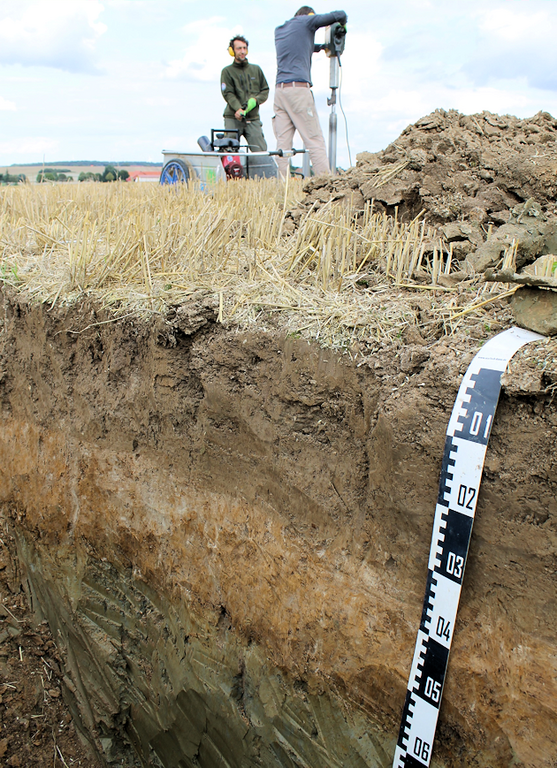Project
SOIL3
![[Translate to English:]](/media/_processed_/5/f/csm_soil3_IMG_5342_1350px_8d9f12f3c8.png)
Sustainable Subsoil Management
Hidden under the organic matter rich surface soil the subsoil is widely ignored as ressource for nutrients and water for plant production. The SOIL3 project aims at investigating the ressources of subsoils on a national scale. Options for an enhanced sustainable use and management of subsoil ressources will be evaluated.
Background and Objective
Plants extract between 10 and 80% of their nutrient and water demand from subsoils, but including the subsoil into sustainable management strategies is still in its fledging stages. In the SOIL3 project we evaluate how and to which degree the subsoil can be managed to secure or even increase plant yields and yield security by improving the overall nutrient and water use efficiency for field crops.
Approach
The rooting depth of crops is the key for agricultural subsoil management. We investigate the factors that determine rooting depth and distribution and evaluate options to facilitate deeper roots. The data from the German soil inventory agricultural and several long-term field experiments will be used to assess for the first time status and options of subsoil ressource use in Germany.
Thünen-Contact

Involved Thünen-Partners
Involved external Thünen-Partners
-
Rheinische Friedrich-Wilhelms-Universität Bonn
(Bonn, Deutschland) -
Technische Universität München
(München, Freising-Weihenstephan, Deutschland) -
Forschungszentrum Jülich
(Jülich, Deutschland) -
Ecologic Institut
(Berlin, Deutschland)
Funding Body
-
Federal Ministry of Research, Technology and Space (BMFTR)
(national, öffentlich)
Duration
10.2015 - 4.2025
More Information
Project funding number: 031B1066E
Funding program: BMFTR - BonaRes
Project status:
finished
Publications
- 0
Burger DJ, Bauke SL, Schneider F, Kappenberg A, Gocke MI (2024) Root-derived carbon stocks in formerly deep-ploughed soils - A biomarker-based approach. Organic Geochem 190:104756, DOI:10.1016/j.orggeochem.2024.104756
- 1
Burger DJ, Schneider F, Bauke SL, Kautz T, Don A, Amelung W (2023) Fifty years after deep-ploughing: Effects on yield, roots, nutrient stocks and soil structure. Eur J Soil Sci 74(6):e13426, DOI:10.1111/ejss.13426
- 2
Gocke MI, Guigue J, Bauke SL, Barkusky D, Baumecker M, Berns AE, Hobley EU, Honermeier B, Kögel-Knabner I, Koszinski S, Sandhage-Hofmann A, Schmidhalter U, Schneider F, Schweitzer K, Seidel SJ, Siebert S, Skadell LE, Sommer M, Tucher S von, Don A, Amelung W (2023) Interactive effects of agricultural management on soil organic carbon accrual: A synthesis of long-term field experiments in Germany. Geoderma 438:116616, DOI:10.1016/j.geoderma.2023.116616
- 3
Skadell LE, Schneider F, Gocke MI, Guigue J, Amelung W, Bauke SL, Hobley EU, Barkusky D, Honermeier B, Kögel-Knabner I, Schmidhalter U, Schweitzer K, Seidel SJ, Siebert S, Sommer M, Vaziritabar Y, Don A (2023) Twenty percent of agricultural management effects on organic carbon stocks occur in subsoils - Results of ten long-term experiments. Agric Ecosyst Environ 356:108619, DOI:10.1016/j.agee.2023.108619
- 4
Schneider F, Amelung W, Don A (2021) Origin of carbon in agricultural soil profiles deduced from depth gradients of C:N ratios, carbon fractions, δ13C and δ15N values. Plant Soil 460:123-148, DOI:10.1007/s11104-020-04769-w
- 5
Schneider F, Poeplau C, Don A (2021) Predicting ecosystem responses by data-driven reciprocal modelling. Global Change Biol 27(21):5670-5679, DOI:10.1111/gcb.15817
- 6
Schneider F, Don A (2019) Root-restricting layers in German agricultural soils. Part I: extent and cause. Plant Soil 442(1-2):433-451, DOI:10.1007/s11104-019-04185-9
- 7
Schneider F, Don A (2019) Root-restricting layers in German agricultural soils. Part II: adaptation and melioration strategies. Plant Soil 442(1-2):419-432, DOI:10.1007/s11104-019-04186-8
- 8
Hobley EU, Honermeier B, Don A, Gocke MI, Amelung W, Kögel-Knabner I (2018) Decoupling of subsoil carbon and nitrogen dynamics after long-term crop rotation and fertilization. Agric Ecosyst Environ 265:363-373, DOI:10.1016/j.agee.2018.06.021
- 9
Bauke SL, Sperber C von, Tamburini F, Gocke MI, Honermeier B, Schweitzer K, Baumecker M, Don A, Sandhage-Hofmann A, Amelung W (2018) Subsoil phosphorus is affected by fertilization regime in long-term agricultural experimental trials. Eur J Soil Sci 69:103-112, DOI:10.1111/ejss.12516
- 10
Schneider F, Don A, Hennings I, Schmittmann O, Seidel SJ (2017) The effect of deep tillage on crop yield - What do we really know? Soil Tillage Res 174:193-204, DOI:10.1016/j.still.2017.07.005

![[Translate to English:] [Translate to English:]](/media/_processed_/6/4/csm_titel_CO2Kampagne8_afeea2273e.png)
![[Translate to English:] [Translate to English:]](/media/_processed_/4/1/csm_titel_93px_CO2Kampagne8_9b0f3354d4.png)






